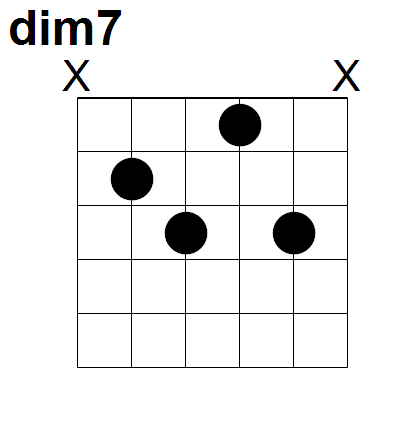I want to do some accompaniments on guitar and am wondering what the easiest barres are for augmented and diminished chords.
-
Do you mean diminished triads or diminished seventh chords? There are no (6-string) barre shapes for diminished and augmented triads.– Matt L.Commented Feb 20, 2016 at 11:22
-
@MattL. - All augs ARE triads, anyway! How could they not be? Need a root to establish, need 3rd to establish maj., need the +5 for the aug. bit... I agree!– TimCommented Feb 20, 2016 at 13:16
-
@Tim: Well, there's also an augmented seventh chord: 1-3-#5-maj7, as depicted in Kirk A's answer.– Matt L.Commented Feb 20, 2016 at 13:29
-
@MattL. - also existing - aug 9thand aug11th. Aug 7 sounds like a bit of a misnomer, as the 7th part isn't actually augmented!– TimCommented Feb 20, 2016 at 15:08
2 Answers
I don't use these chords much so I can probably only remember the easy ones!
I'm lazy too - I tend to use this dim7 when I need a dim. It's not a barre, but it is moveable as it uses no open strings, and sounds good for arpeggiating.
Another movable dim and dim7 that I like are:


As for aug, there's really only one moveable shape I use (again not a barre.) The next three diagrams all represent the same intervals, just changing shape as it moves across the fretboard:



Here are some diminished and augmented seventh grips; the third diminished one is perhaps my favorite (you may recognize it as a major seventh rooted on the A-string, but with the root pushed up a semitone and the seventh dropped a semitone). Only the last grip -- which can be a stretch depending upon your position -- is really suitable for arpeggios. Several of the augmented (major seventh sharp fifth) shapes further below lend themselves to arpeggios.
Dim7:
╫─1─╫───╫ E
╫───╫───╫ A
╫───╫♭♭7╫ D
╫♭3─╫───╫ G
╫───╫♭5─╫ B
╫───╫───╫ e
╫───╫─1─╫───╫ E
╫♭5─╫───╫───╫ A
╫───╫───╫♭♭7╫ D
╫───╫♭3─╫───╫ G
╫───╫───╫───╫ B
╫───╫───╫───╫ e
╫───╫───╫───╫ E
╫───╫─1─╫───╫ A
╫♭5─╫───╫───╫ D
╫───╫───╫♭♭7╫ G
╫♭3─╫───╫───╫ B
╫───╫───╫───╫ e
╫───╫───╫───╫ E
╫───╫─1─╫───╫ A
╫───╫───╫───╫ D
╫───╫───╫♭♭7╫ G
╫♭3─╫───╫───╫ B
╫───╫───╫♭5─╫ e
╫───╫───╫ E
╫───╫───╫ A
╫───╫─1─╫ D
╫♭5─╫───╫ G
╫───╫♭♭7╫ B
╫♭3─╫───╫ e
╫───╫───╫───╫───╫───╫───╫ E
╫───╫───╫───╫───╫───╫───╫ A
╫─1─╫───╫───╫───╫───╫───╫ D
╫───╫───╫♭3─╫───╫───╫───╫ G
╫───╫───╫───╫♭5─╫───╫───╫ B
╫───╫───╫───╫───╫───╫♭♭7╫ e
Major7#5:
╫───╫─1─╫ E
╫───╫───╫ A
╫─7─╫───╫ D
╫─3─╫───╫ G
╫♯5─╫───╫ B
╫───╫───╫ e
╫─1─╫───╫───╫───╫───╫ E
╫───╫─3─╫───╫───╫───╫ A
╫───╫───╫♯5─╫───╫───╫ D
╫───╫───╫───╫───╫─7─╫ G
╫───╫───╫───╫───╫───╫ B
╫───╫───╫───╫───╫───╫ e
╫───╫───╫───╫───╫ E
╫───╫───╫───╫─1─╫ A
╫♯5─╫───╫───╫───╫ D
╫───╫───╫─7─╫───╫ G
╫───╫─3─╫───╫───╫ B
╫───╫───╫───╫───╫ e
╫───╫───╫───╫───╫ E
╫─1─╫───╫───╫───╫ A
╫───╫─3─╫───╫───╫ D
╫───╫───╫♯5─╫───╫ G
╫───╫───╫───╫─7─╫ B
╫───╫───╫───╫───╫ e
╫───╫───╫───╫───╫ E
╫───╫───╫───╫───╫ A
╫───╫───╫───╫─1─╫ D
╫♯5─╫───╫───╫───╫ G
╫───╫─7─╫───╫───╫ B
╫───╫─3─╫───╫───╫ e
╫───╫───╫───╫───╫ E
╫───╫───╫───╫───╫ A
╫─1─╫───╫───╫───╫ D
╫───╫─3─╫───╫───╫ G
╫───╫♯5─╫───╫───╫ B
╫───╫───╫───╫─7─╫ e
Enjoy.
-
We have JTab on this site which would look generate the chord diagrams a lot better than the ascii counterpart. Why don't you try and convert it?– Dom ♦Commented Feb 20, 2016 at 12:04
-
@Dom, I have retained this archaic format because it clearly identifies the constituent voices. JTab labels them with fingers and thumb; that much is self-evident.– Kirk ACommented Feb 20, 2016 at 12:17
-
You can stick whatever you want in the fingering spot. For example this
%X/x.X/X.4/1.3/3.3/#5.1/7[E+7]would be your last diagram. Try it out here on the jTab sandbox: jtab.tardate.com– Dom ♦Commented Feb 20, 2016 at 12:28 -
Forget the jTab. I forgot the issues about doing more than one in a code block...– Dom ♦Commented Feb 20, 2016 at 12:46

